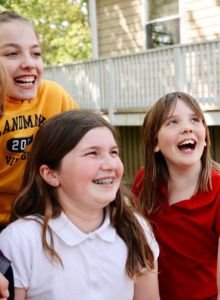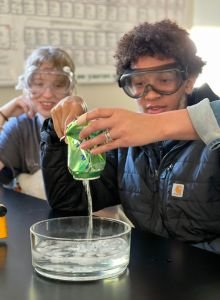- Our School
- Our Advantage
- Admission
- Elementary•Middle School
- High School
- Summer
- Giving
- Parent Resources
- For Educators
- Alumni

One Family’s Story
By Chrissy Kenney
Landmark High School junior Naomi Welles doesn’t complete any task casually. In third grade Naomi explained to her mom, “My mind works differently than most kids. Others think linear and straightforward, but I see and think more in a sphere.”
Not A Simple Wind Up
Ask her to throw a baseball, and you might expect her to simply wind up and release her grip on the ball. For Naomi, it’s not quite that simple. “I first need to understand the right angle to throw the ball. I think about how much wind might be blowing. Should I use my core or twist my body to gain momentum?” Naomi reflected.
Naomi turns the task into a math problem, a language she can easily understand. She is conscientious and puts much thought into all of her decisions. Naomi also attributes her ability to problem solve by combining her love of math and intense imagination to the very challenge her family feared might hold her back: her dyslexia.
“Dyslexia has helped me become who I am. It has made me so much stronger than I would be otherwise. Growing up, when I struggled, my mom would always tell me, ‘Naomi, you’re learning the most important lesson in life: to work hard,’” Naomi shared.
Today, Naomi is ambitious with a passion for learning, but her path to Landmark was challenging. She feels that at Landmark she is learning more about how she thinks about her disability and that she is getting the tools and help she needs to realize her full potential.
Like Mother Like Daughter
Naomi’s mother, Jessica, also has dyslexia. Jessica is from Sweden and attended an international school in Spain. As a young student, she used many coping skills. She was able to easily pick up foreign languages and often served as a translator between teachers and students, in English, Swedish, and Spanish. When it came to reading, she would deflect with humor by being the entertainer of the class. She was also a strong athlete, which helped build her confidence.
Jessica believes in exposing children to different types of learning early—teaching her daughters how to read when they were young toddlers. Reading was an important part of their family life. Naomi’s passion for books and storytelling could have been hindered by her dyslexia, but her younger sister Annika’s love for reading helped them grow closer. They were a perfect team. Annika would often handle the reading and writing-related tasks. Naomi oversaw anything math related. Naomi used this as a strategy to navigate the world around her, but Annika was only available at home—not at school.
Path to Landmark
Naomi was formally diagnosed with dyslexia and dysgraphia in third grade. Even though the family went so far as to move towns to get Naomi the appropriate school support, her teachers struggled to understand why such a smart and hardworking student wasn’t progressing in reading and writing.
“It’s a struggle to accept that your child has dyslexia, especially when you know firsthand the painful path ahead and challenges that come along with it,” Jessica said.
When local public school, public online school, and private tutoring didn’t address Naomi’s academic needs, Jessica and her husband, David, fiercely advocated on behalf of Naomi, which eventually led to her enrollment at Landmark High School. And because the family lives so far from campus, they made the difficult decision to have Naomi board, which was worth it in the long run.
While Naomi loves her classes, the social aspect of Landmark has perhaps benefited her the most. As a young student, the discrepancy between her ability to break down the written language and her powerful mind formed a wedge between her and her classmates. This was only reinforced by the numerous pull-out sessions that additionally separated her from the rest of her classmates. She felt isolated and singled out. Her self-esteem took a toll.
Breaking Barriers
Today, Naomi loves attending a school where students’ learning differences are celebrated and their educational needs are met with an individualized program.
Naomi was understandably guarded upon arriving at Landmark, having experienced some prior bullying and isolation. A coping skill she had used was to hide and try to not be seen. When a classmate at Landmark noticed that Naomi seemed disengaged, he offered his friendship and some well-received advice: “We are all dyslexic here. You don’t need to hide anymore. If you ever feel alone, just come and get me.”
This advice has stuck with Naomi. When asked about the wedge dyslexia created in her social life, she said, “That barrier is gone, and I am slowly learning to trust teachers and peers.” At Landmark today, Naomi is navigating this new experience one step at a time, trying out many different clubs and after-school activities. So far, she has participated in dance, track and field, cross country, climbing club, chorus, the sailing team, and various service projects. And she’s thrilled with every opportunity she gets to give tours of Landmark to potential students and families.
After Landmark, Naomi plans to attend college, and her list of potential careers is about 100 deep. We know one truth with certainty: Naomi will put a great deal of thought into what she decides to pursue next, and she will work incredibly hard to accomplish it.
Upon reflection, Naomi offered: “Dyslexia has taught me how to work 10 times harder than others. When I’m older, that’s going to help me.”
Many would argue it already has.
Article originally published in The Lantern, Fall 2022/Winter 2023















